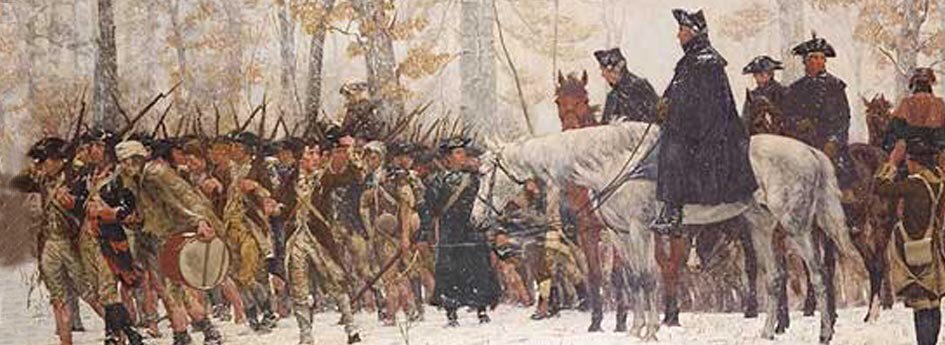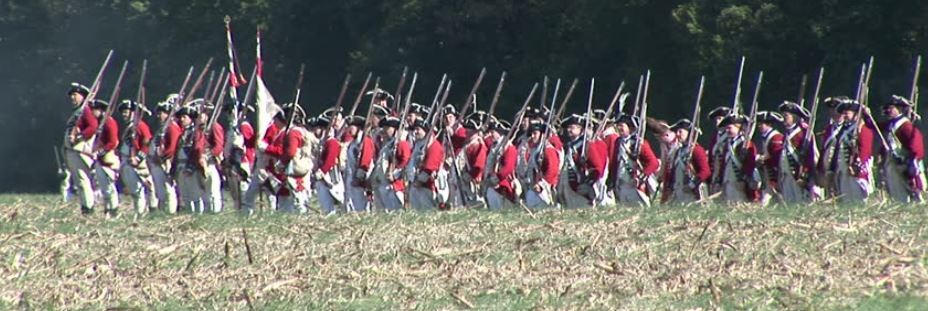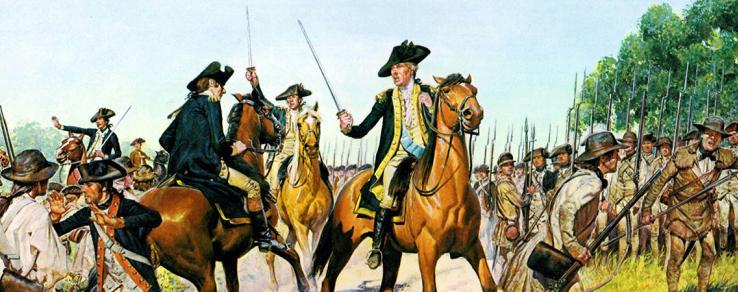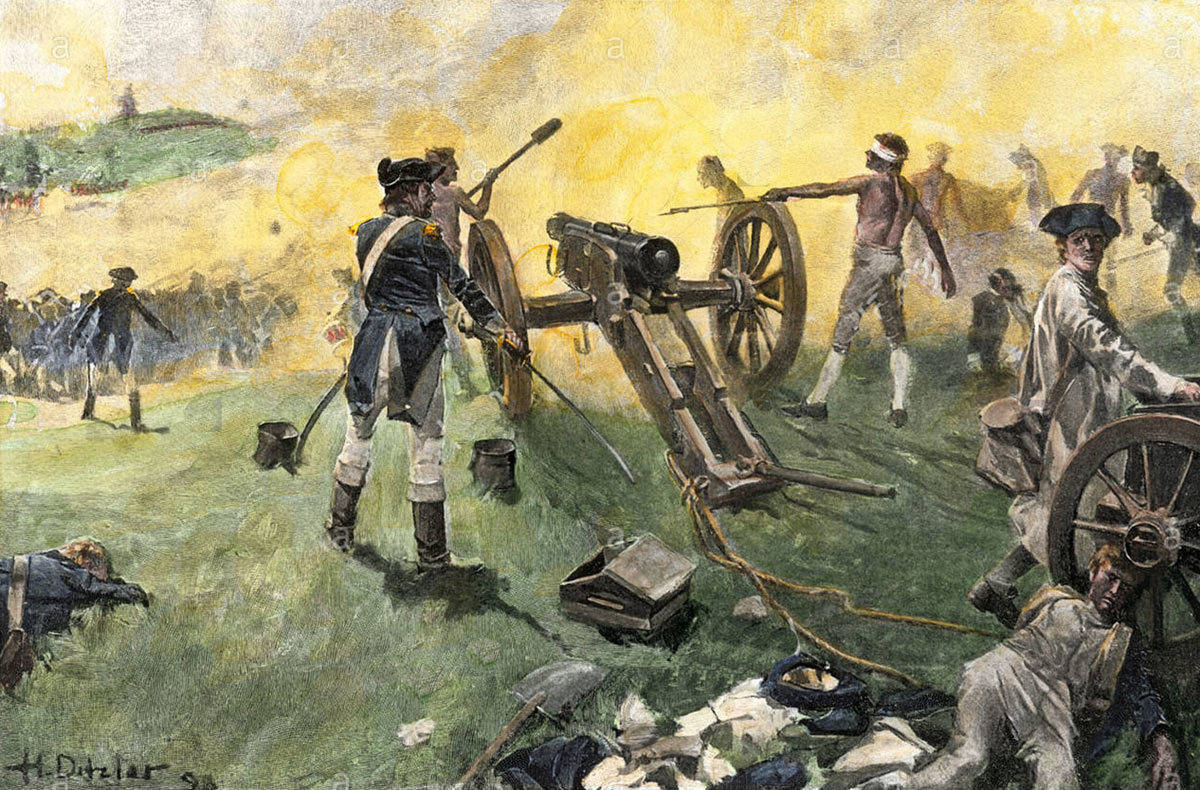Background to the Battle of Monmouth
General George Washington and his American army spent the winter of 1777/8 at Valley Forge in considerably straightened circumstances. As the winter wore on, the supply situation was brought under control and something approaching a proper issue of equipment and rations was made to the American troops. The Prussian officer, General Steuben, established a system of military training for the American regiments, teaching them a form of Prussian battle drill, adapted to suit American troops.
 ” Valley Forge"
” Valley Forge"
British evacuation of Philadelphia in June 1778
The British army spent the winter in Philadelphia. Lieutenant-General Howe returned to England, relieved of his appointment in command in America at his own request, to be replaced by Lieutenant-General Sir Henry Clinton. Clinton was under orders to evacuate Philadelphia and concentrate the British forces in New York.
On 18th June 1778, Clinton’s British army, with artillery, supplies and the loyalist populace of the city, left Philadelphia and began the laborious march cross country to the North-East. Clinton’s intention, in accordance with his orders, was to march to New York. The first week of the march convinced him that his army with its train was too cumbersome to make the journey by land. In addition, it was reported that General Gates was moving from the Hudson River valley with his American army to block the British retreat. Clinton decided to divert to the coast and take ship. At Allentown, his British and German army branched off the main route towards Monmouth to head north-east.
 ”Clinton’s British army"
”Clinton’s British army"
Hearing that the British were on the move, General Washington marched his army east from Valley Forge, seeking to intercept the slow-moving British column. He did so at Monmouth Courthouse. General Washington hurried his army forward to intercept the British withdrawal. An advanced force of some 4,000 American troops was allocated to attack the marching British Army and cut it in half.
Washington offered the command of this assault to Major-General Charles Lee. Initially Lee refused the appointment, lacking confidence in the success of the plan. When the force was increased to 5,000 men and given to the Marquis de Lafayette, Lee changed his mind and insisted on having the command. Lee’s task was to attack the British column in flank and delay it, so the main American army could come up and give battle.
The weather was unsettled, high day-time temperatures giving way to heavy rainstorms. On 28th June 1778, suspecting that Washington intended to attack his army in strength, General Clinton ordered General Knyphausen to begin his march up the Middletown road to the North that day at 4am. Warned by Dickinson and his New Jersey militia that Clinton’s army was on the move, Washington ordered Lee to attack and delay the British march, until he could bring up the main strength of the American army along the Monmouth Road.
Lee lay to the west of the Middletown road and was expected to deliver an attack on the slow-moving British column. Properly executed, such an attack would have halted the British march to the north-east and enabled the main American army under Washington to attack Clinton’s army in the rear.
 ” Washington encounters Lee's retreat"
” Washington encounters Lee's retreat"
Washington detached around a third of his army and sent it ahead under the command of Major General Charles Lee, hoping to land a heavy blow on the British without becoming embroiled in a major engagement. The battle began badly for the Americans when Lee botched an attack on the British rearguard at Monmouth Court House.
Lee gave no proper orders to his commanders and permitted them to act as they saw fit. Skirmishes with parties of British troops took place, as Lee’s force moved tentatively forward towards the Middletown Road. Confused fighting broke out with Clinton’s rear-guard, largely composed of British regiments. The counter-attack by the main British column forced Lee to retreat until Washington arrived with the main body. Finally, Lee ordered his troops to retreat on the main American army. As Lee withdrew down the road, Clinton launched his troops in pursuit.
General Washington, bringing the main American army along the Monmouth road, encountered, not the rear of the British column, but Lee’s regiments, retreating in considerable disorder, with the British advancing behind them.This is said to be the one occasion that Washington swore. He unleashed a volley of oaths at Lee, to the admiration of those listening, before ordering Lee to the rear. Washington then galloped forward and began the task of rallying Lee’s disordered troops.
 ”Battle of Monmouth Map"
”Battle of Monmouth Map"
Washington ordered General Wayne, with the last of Lee’s regiments, Stewart’s 13th Pennsylvania and Ramsay’s 3rd Maryland, to form to the north of the road and hold the British advance. These regiments resisted strongly but were driven back by the British 16th Light Dragoons. Their stand gave Washington the time to form the rest of the American army, with artillery on Comb’s Hill to the south of the road, enfilading the attacking British foot. Fierce fighting took place as the British attempted to drive back the American line. This was the first test for Steuben’s newly trained American Continental regiments of foot, and they withstood the trial well. As the evening wore on, the British troops fell back and returned to their journey north, leaving the Americans on the field.
The Largest Land Artillery Battle of Revolutionary War
 ”Battle of Monmouth"
”Battle of Monmouth"
As the British Guards and Grenadiers pushed across the Dividing Brook. After brief, bloody clashes in a wood lot and along the hedgerow, the Continentals under General Lee fell back across Spotswood Middle Brook. As the British charged the bridge, they found the Continental Army occupying a very strong position on the Perrine Farm hill behind a line of ten guns. Exhausted by a forced march and cannonaded with grapeshot, the British soldiers faltered and the attack collapsed. British light infantry attempted to outflank the Continental position, but withdrew when they found Lafayette waiting for them with the Continental reserves . To silence the Continental artillery commanding the bridge, the British positioned ten cannon and howitzers in front of the hedgerow. For hours during the afternoon, the largest field artillery battle of the American Revolution raged.
 ”Battle of Monmouth"
”Battle of Monmouth"
A fiercely fought rearguard action by the vanguard gave Washington enough time to deploy the main body in a strong defensive position, against which British efforts to press the vanguard foundered. The infantry battle gave way to a two-hour artillery duel, during which Clinton began to disengage. The duel ended when a Continental brigade established artillery on a hill overlooking the British lines, forcing Clinton to withdraw his guns. Washington launched two small-unit attacks on Clinton's infantry as they withdrew, inflicting heavy casualties on the British during the second.
The Continental artillery won the duel when in the late afternoon, General Nathaniel Greene brought a brigade of Virginians and four guns to the top of Combs Hill. The American guns raked the hedgerow, forcing the British artillery to withdraw and their infantry to shift position.
 ”General Nathaniel Greene brought a brigade of Virginians and four guns to the top of Combs Hill"
”General Nathaniel Greene brought a brigade of Virginians and four guns to the top of Combs Hill"
As the British artillery fell silent, Washington cautiously counterattacked. First, two battalions of New Englanders light infantry advanced along Spotswood, North Brook to skirmish with the retreating Royal Highlanders. Then General Anthony Wayne led three small regiments across the bridge to attack the withdrawing British Grenadiers. After heavy, stubborn fighting, Wayne’s men were forced back into the shelter of the parsonage buildings and orchard. Again raked by Continental artillery, the British pulled back across the Dividing Brook and made camp. An attempt by Washington to probe the British flanks was halted by sunset, and the two armies settled down within one mile of each other.
General George Washington moved fresh troops forward to resume the battle at dawn, but around 11 p.m. the British forces resumed their march to New York City, thus ending the last major battle of the north. The Battle of Monmouth was a political triumph for the Continental Army and General George Washington.
 ”Battle of Monmouth State Park Map"
”Battle of Monmouth State Park Map"
General George Washington moved fresh troops forward to resume the battle at dawn, but Clinton disengaged when he found Washington in an unassailable defensive moved the British forced and slipped away unnoticed during the night and resumed the march to Sandy Hook. The rest of the march to Sandy Hook was completed without further incident, and Clinton's army was ferried to New York This ended the last major battle in the North.
General Charles Lee was an idiotic ex-British French and Indian war officer who had settled in America after. This battle had raised the morale of the Americans and secured most of New Jersey for America. The Battle of Monmouth had confided a great number of Northern British soldiers to New York.
The battle was tactically inconclusive and strategically irrelevant; neither side landed the blow they hoped to on the other, Washington's army remained an effective force in the field and the British redeployed successfully to New York. The Continental Army inflicted more casualties than it suffered, and it was one of the rare occasions on which it retained possession of a battlefield. It had proven itself to be much improved after the training it underwent over the winter, and the professional conduct of the American troops during the battle was widely noted by the British.
Washington was able to present the battle as a triumph, and he was voted a formal thanks by Congress to honor "the important victory of Monmouth over the British grand army." His position as commander-in-chief became unassailable. He was lauded for the first time as the Father of his Country, and his detractors were silenced. Lee was vilified for his failure to press home the attack on the British rearguard. Because of his tactless efforts to argue his case in the days after the battle, Washington had him arrested and court-martialed on charges of disobeying orders, conducting an "unnecessary, disorderly, and shameful retreat" and disrespect towards the commander-in-chief. Lee made the fatal mistake of turning the proceedings into a contest between himself and Washington. He was found guilty on all counts, although his culpability on the first two charges was debatable.
Casualties at the Battle of Monmouth:
The British suffered some 300 casualties and the Americans 350. Up to 100 men are thought to have died of heatstroke during the battle.
During the march from Philadelphia, Clinton’s army lost around 550 deserters, of whom 450 were from the Hessian regiments. This is a striking figure. In the course of a few days, Clinton lost the equivalent of a battalion. Some of these men will have joined American regiments. Many, particularly German soldiers, are believed to have returned to Philadelphia to resume domestic relationships.
This cache is one of "The American Revolution Geo~Trail" caches throughout New Jersey. These special geocaches are hidden at historic locations which have a connection to important New Jersey's American Revolutionary War history. To participate in the optional Geo-Trail, after you find the geocache, locate the secret code and record it into your passport which you will print from the Geo~Trail website. Information at njpatriots.org
 ”njpatriots.org"
”njpatriots.org"
The Northern New Jersey Cachers, NNJC is about promoting a quality caching experience in New Jersey. For information on The Northern New Jersey Cachers group you can visit: www.nnjc.org.
 nnjc.org & metrogathering.org, & njpatriots.org
nnjc.org & metrogathering.org, & njpatriots.org

Geocache Identification Permit Approval Number:20230327003
Permit Expires on:3/27/2026
The Northern New Jersey Cachers, NNJC is about promoting a quality caching experience in New Jersey. For information on The Northern New Jersey Cachers group you can visit: www.nnjc.org.
 nnjc.org & metrogathering.org, & njpatriots.org
nnjc.org & metrogathering.org, & njpatriots.org